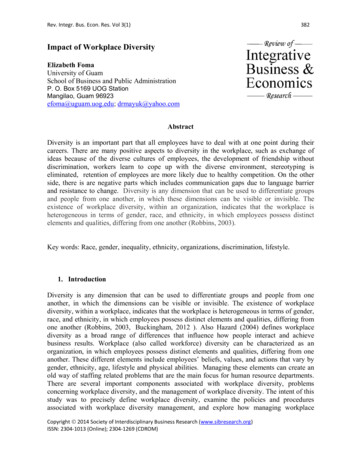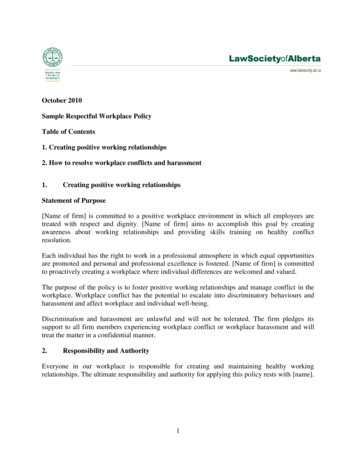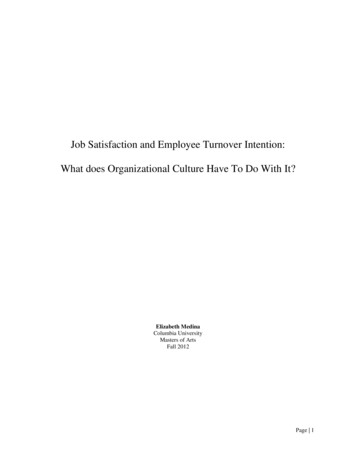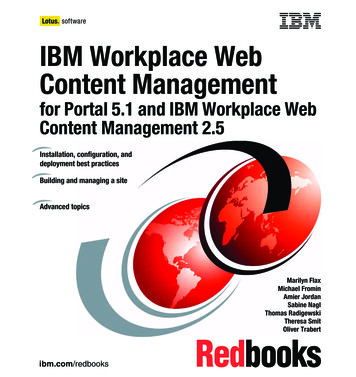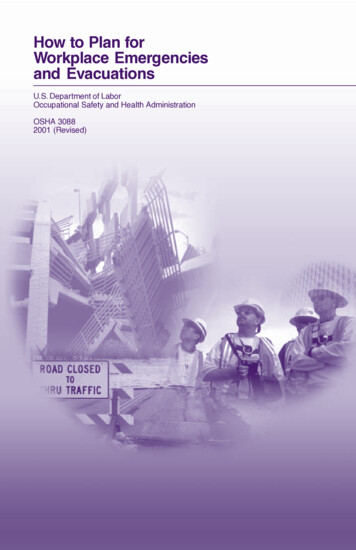
Transcription
How to Plan forHow to PlanEmergenciesforWorkplaceWorkplaceEmergenciesand Evacuationsand EvacuationsU.S. Department of LaborOccupationalSafetyand Health AdministrationU.S. Departmentof LaborOccupational Safety and Health AdministrationOSHA 30882001OSHA(Revised)30882001 (Revised)1
How to Plan for WorkplaceEmergencies and EvacuationsOSHA 30882001 (Revised)This booklet provides a generic overview of a standards-relatedtopic. This publication does not alter or determine complianceresponsibilities, which are described in the OSHA standards andthe Occupational Safety and Health Act. Because interpretationsand enforcement policy may change over time, the best sources foradditional guidance on OSHA compliance requirements are currentadministrative interpretations and decisions by the Occupational Safetyand Health Review Commission and the courts. This publication is inthe public domain and may be reproduced fully or partially withoutpermission. Source credit is requested but not required.OSHA will make this information available to sensory impairedindividuals upon request. Call (202) 693-1999.
Table of ContentsIntroduction . . . . . . . . . . . . . . . . . . . . . . . . . . . . . . . . . . . . . . . . . . . . . . . . . . . . . 4What is a workplace emergency? . . . . . . . . . . . . . . . . . . . . . . . . . . . . . . . . . . 4How do you protect yourself, your employees, and your business? . . . . 4What is an emergency action plan? . . . . . . . . . . . . . . . . . . . . . . . . . . . . . . . . 5What should your emergency action plan include? . . . . . . . . . . . . . . . . . . . 5How do you alert employees to an emergency? . . . . . . . . . . . . . . . . . . . . . 7How do you develop an evacuation policy and procedures? . . . . . . . . . . 7Under what conditions should you call for an evacuation? . . . . . . . . . . . . 8What is the role of coordinators and evacuation wardensduring an emergency? . . . . . . . . . . . . . . . . . . . . . . . . . . . . . . . . . . . . . . . . . . . 9How do you establish evacuation routes and exits? . . . . . . . . . . . . . . . . . 10How do you account for employees after an evacuation? . . . . . . . . . . . . 10How should you plan for rescue operations? . . . . . . . . . . . . . . . . . . . . . . . 10What medical assistance should you provide during an emergency? . . 11What role should employees play in your emergency action plan? . . . . 11What employee information should your plan include? . . . . . . . . . . . . . . 12What type of training do your employees need? . . . . . . . . . . . . . . . . . . . . 12How often do you need to train your employees? . . . . . . . . . . . . . . . . . . . 13What does your plan need to include about hazardous substances? . . . 13What special equipment should you provide for emergencies? . . . . . . . 14How do you choose appropriate respirators and other equipment? . . . 14Who should you coordinate with when drafting youremergency action plan? . . . . . . . . . . . . . . . . . . . . . . . . . . . . . . . . . . . . . . . . . 15What are OSHA’s requirements for emergencies? . . . . . . . . . . . . . . . . . . . 15What other OSHA standards address emergency planningrequirements? . . . . . . . . . . . . . . . . . . . . . . . . . . . . . . . . . . . . . . . . . . . . . . . . . . 16What assistance does OSHA provide? . . . . . . . . . . . . . . . . . . . . . . . . . . . . . 17What education and training does OSHA offer? . . . . . . . . . . . . . . . . . . . . 18What other publications does OSHA offer? . . . . . . . . . . . . . . . . . . . . . . . . .18What electronic services does OSHA provide? . . . . . . . . . . . . . . . . . . . . . . 19What free onsite consultation services does OSHA provide? . . . . . . . . . 19What are the Voluntary Protection Programs? . . . . . . . . . . . . . . . . . . . . . . 20What partnership opportunities does OSHA provide? . . . . . . . . . . . . . . . 21What is the value of a good safety and health program? . . . . . . . . . . . . . 21What is the role of state programs? . . . . . . . . . . . . . . . . . . . . . . . . . . . . . . . 21What other groups or associations can help me? . . . . . . . . . . . . . . . . . . . 22Appendices . . . . . . . . . . . . . . . . . . . . . . . . . . . . . . . . . . . . . . . . . . . . . . . . . . . . 23
IntroductionNobody expects an emergency or disaster -- especially one thataffects them, their employees, and their business personally. Yet thesimple truth is that emergencies and disasters can strike anyone,anytime, and anywhere. You and your employees could be forced toevacuate your company when you least expect it.This booklet is designed to help you, the employer, plan for thatpossibility. The best way to protect yourself, your workers, andyour business is to expect the unexpected and develop a wellthought-out emergency action plan to guide you when immediateaction is necessary.What is a workplace emergency?A workplace emergency is an unforeseen situation that threatensyour employees, customers, or the public; disrupts or shuts downyour operations; or causes physical or environmental damage.Emergencies may be natural or manmade and include the following: Floods,Hurricanes,Tornadoes,Fires,Toxic gas releases,Chemical spills, Radiological accidents,Explosions,Civil disturbances, andWorkplace violence resultingin bodily harm and trauma.How do you protect yourself, your employees, andyour business?The best way is to prepare to respond to an emergency before ithappens. Few people can think clearly and logically in a crisis, so it isimportant to do so in advance, when you have time to be thorough.Brainstorm the worst-case scenarios. Ask yourself what you woulddo if the worst happened. What if a fire broke out in your boilerroom? Or a hurricane hit your building head-on? Or a train carryinghazardous waste derailed while passing your loading dock? Onceyou have identified potential emergencies, consider how they wouldaffect you and your workers and how you would respond.4
What is an emergency action plan?An emergency action plan covers designated actions employersand employees must take to ensure employee safety from fire andother emergencies. Not all employers are required to establishan emergency action plan. See the flowchart on page 17 todetermine if you are. Even if you are not specifically required to doso, compiling an emergency action plan is a good way to protectyourself, your employees, and your business during an emergency.Putting together a comprehensive emergency action plan that dealswith all types of issues specific to your worksite is not difficult.You may find it beneficial to include your management team andemployees in the process. Explain your goal of protecting lives andproperty in the event of an emergency, and ask for their help inestablishing and implementing your emergency action plan. Theircommitment and support are critical to the plan’s success.What should your emergency action plan include?When developing your emergency action plan, it’s a good idea tolook at a wide variety of potential emergencies that could occur inyour workplace. It should be tailored to your worksite and includeinformation about all potential sources of emergencies. Developingan emergency action plan means you should do a hazardassessment to determine what, if any, physical or chemical hazardsin your workplaces could cause an emergency. If you have morethan one worksite, each site should have an emergency action plan.At a minimum, your emergency action plan must include the following: A preferred method for reporting fires and other emergencies; An evacuation policy and procedure; Emergency escape procedures and route assignments, such asfloor plans, workplace maps, and safe or refuge areas;5
Names, titles, departments, and telephone numbers ofindividuals both within and outside your company to contactfor additional information or explanation of duties andresponsibilities under the emergency plan; Procedures for employees who remain to perform or shut downcritical plant operations, operate fire extinguishers, or performother essential services that cannot be shut down for everyemergency alarm before evacuating; and Rescue and medical duties for any workers designated toperform them.You also may want to consider designating an assembly locationand procedures to account for all employees after an evacuation.In addition, although they are not specifically required by OSHA,you may find it helpful to include in your plan the following: The site of an alternative communications center to be used inthe event of a fire or explosion; and A secure on- or offsite location to store originals or duplicatecopies of accounting records, legal documents, your employees’emergency contact lists, and other essential records.6
How do you alert employees to an emergency?Your plan must include a way to alert employees, including disabledworkers, to evacuate or take other action, and how to reportemergencies, as required. Among the steps you must take are thefollowing: Make sure alarms are distinctive and recognized by allemployees as a signal to evacuate the work area or performactions identified in your plan; Make available an emergency communications system such asa public address system, portable radio unit, or other meansto notify employees of the emergency and to contact local lawenforcement, the fire department, and others; and Stipulate that alarms must be able to be heard, seen, orotherwise perceived by everyone in the workplace. You mightwant to consider providing an auxiliary power supply in theevent that electricity is shut off. (29 CFR 1910.165(b)(2) offersmore information on alarms.)Although it is not specifically required by OSHA, you also may wantto consider the following: Using tactile devices to alert employees who would nototherwise be able to recognize an audible or visual alarm; and Providing an updated list of key personnel such as the plantmanager or physician, in order of priority, to notify in the eventof an emergency during off-duty hours.How do you develop an evacuation policyand procedures?A disorganized evacuation can result in confusion, injury, andproperty damage. That is why when developing your emergencyaction plan it is important to determine the following: Conditions under which an evacuation would be necessary; A clear chain of command and designation of the person in yourbusiness authorized to order an evacuation or shutdown. Youmay want to designate an “evacuation warden” to assist othersin an evacuation and to account for personnel; Specific evacuation procedures, including routes and exits. Postthese procedures where they are easily accessible to all employees;7
Procedures for assisting people with disabilities or who do notspeak English; Designation of what, if any, employees will continue or shutdown critical operations during an evacuation. These peoplemust be capable of recognizing when to abandon the operationand evacuate themselves; and A system for accounting for personnel following anevacuation. Consider employees’ transportation needs forcommunity-wide evacuations.Under what conditions should you call foran evacuation?In the event of an emergency, local emergency officials may orderyou to evacuate your premises. In some cases, they may instructyou to shut off the water, gas, and electricity. If you have access toradio or television, listen to newscasts to keep informed and followwhatever official orders you receive.In other cases, a designated person within your business shouldbe responsible for making the decision to evacuate or shutdown operations. Protecting the health and safety of everyonein the facility should be the first priority. In the event of a fire,an immediate evacuation to a predetermined area away fromthe facility is the best way to protect employees. On the otherhand, evacuating employees may not be the best response to anemergency such as a toxic gas release at a facility across town fromyour business.The type of building you work in may be a factor in your decision.Most buildings are vulnerable to the effects of disasters such astornadoes, earthquakes, floods, or explosions. The extent of thedamage depends on the type of emergency and the building’sconstruction. Modern factories and office buildings, for example, areframed in steel and are structurally more sound than neighborhoodbusiness premises may be. In a disaster such as a major earthquakeor explosion, however, nearly every type of structure will beaffected. Some buildings will collapse and others will be left withweakened floors and walls.8
What is the role of coordinators and evacuationwardens during an emergency?When drafting your emergency action plan, you may wish to selecta responsible individual to lead and coordinate your emergencyplan and evacuation. It is critical that employees know who thecoordinator is and understand that person has the authority to makedecisions during emergencies.The coordinator should be responsible for the following: Assessing the situation to determine whether an emergencyexists requiring activation of your emergency procedures; Supervising all efforts in the area, including evacuating personnel; Coordinating outside emergency services, such as medical aidand local fire departments, and ensuring that they are availableand notified when necessary; and Directing the shutdown of plant operations when required.You also may find it beneficial to coordinate the action plan withother employers when several employers share the worksite,although OSHA standards do not specifically require this.In addition to a coordinator, you may want to designate evacuationwardens to help move employees from danger to safe areas duringan emergency. Generally, one warden for every 20 employeesshould be adequate, and the appropriate number of wardens shouldbe available at all times during working hours.Employees designated to assist in emergency evacuationprocedures should be trained in the complete workplace layoutand various alternative escape routes. All employees and thosedesignated to assist in emergencies should be made aware ofemployees with special needs who may require extra assistance,how to use the buddy system, and hazardous areas to avoid duringan emergency evacuation.9
How do you establish evacuation routes and exits?When preparing your emergency action plan, designate primary andsecondary evacuation routes and exits. To the extent possible underthe conditions, ensure that evacuation routes and emergency exitsmeet the following conditions: Clearly marked and well lit;Wide enough to accommodate the number of evacuating personnel;Unobstructed and clear of debris at all times; andUnlikely to expose evacuating personnel to additional hazards.If you prepare drawings that show evacuation routes and exits, postthem prominently for all employees to see.How do you account for employees afteran evacuation?Accounting for all employees following an evacuation is critical.Confusion in the assembly areas can lead to delays in rescuinganyone trapped in the building, or unnecessary and dangeroussearch-and-rescue operations. To ensure the fastest, most accurateaccountability of your employees, you may want to considerincluding these steps in your emergency action plan: Designate assembly areas where employees should gatherafter evacuating; Take a head count after the evacuation. Identify the names andlast known locations of anyone not accounted for and pass themto the official in charge; Establish a method for accounting for non-employees such assuppliers and customers; and Establish procedures for further evacuation in case the incidentexpands. This may consist of sending employees home bynormal means or providing them with transportation to anoffsite location.How should you plan for rescue operations?It takes more than just willing hands to save lives. Untrainedindividuals may endanger themselves and those they are trying torescue. For this reason, it is generally wise to leave rescue work tothose who are trained, equipped, and certified to conduct rescues.10
If you have operations that take place in permit-required confinedspaces, you may want your emergency action plan to include rescueprocedures that specifically address entry into each confined space.(See also OSHA Publication 3138, Permit-Required Confined Spaces,and the National Institute for Occupational Safety and Health(NIOSH) Publication 80-106, Criteria for a Recommended Standard.Working in Confined Spaces.)What medical assistance should you provide duringan emergency?If your company does not have a formal medical program, you maywant to investigate ways to provide medical and first-aid services.If medical facilities are available near your worksite, you canmake arrangements for them to handle emergency cases. Provideyour employees with a written emergency medical procedure tominimize confusion during an emergency.If an infirmary, clinic, or hospital is not close to your workplace,ensure that onsite person(s) have adequate training in first aid.The American Red Cross, some insurance providers, local safetycouncils, fire departments, or other resources may be able toprovide this training. Treatment of a serious injury should beginwithin 3 to 4 minutes of the accident.Consult with a physician to order appropriate first-aid supplies foremergencies. Medical personnel must be accessible to provideadvice and consultation in resolving health problems that occurin the workplace. Establish a relationship with a local ambulanceservice so transportation is readily available for emergencies.What role should employees play in youremergency action plan?The best emergency action plans include employees in the planningprocess, specify what employees should do during an emergency,and ensure that employees receive proper training for emergencies.When you include your employees in your planning,encouragethem to offer suggestions about potential hazards, worst-casescenarios, and proper emergency responses. After you develop theplan, review it with your employees to make sure everyone knowswhat to do before, during and after an emergency.11
Keep a copy of your emergency action plan in a convenient locationwhere employees can get to it, or provide all employees a copy. If youhave 10 or fewer employees, you may communicate your plan orally.What employee information should yourplan include?In the event of an emergency, it could be important to have readyaccess to important personal information about your employees.This includes their home telephone numbers, the names andtelephone numbers of their next of kin, and medical information.What type of training do your employees need?Educate your employees about the types of emergencies that mayoccur and train them in the proper course of action. The size of yourworkplace and workforce, processes used, materials handled, andthe availability of onsite or outside resources will determine yourtraining requirements. Be sure all your employees understand thefunction and elements of your emergency action plan, includingtypes of potential emergencies, reporting procedures, alarmsystems, evacuation plans, and shutdown procedures. Discuss anyspecial hazards you may have onsite such as flammable materials,toxic chemicals, radioactive sources, or water-reactive substances.Clearly communicate to your employees who will be in chargeduring an emergency to minimize confusion.General training for your employees should address the following: Individual roles and responsibilities;Threats, hazards, and protective actions;Notification, warning, and communications procedures;Means for locating family members in an emergency;Emergency response procedures;Evacuation, shelter, and accountability procedures;Location and use of common emergency equipment; andEmergency shutdown procedures.You also may wish to train your employees in first-aid procedures,including protection against bloodborne pathogens; respiratoryprotection, including use of an escape-only respirator; and methodsfor preventing unauthorized access to the site.12
Once you have reviewed your emergency action plan with youremployees and everyone has had the proper training, it is a goodidea to hold practice drills as often as necessary to keep employeesprepared. Include outside resources such as fire and policedepartments when possible. After each drill, gather managementand employees to evaluate the effectiveness of the drill. Identify thestrengths and weaknesses of your plan and work to improve it.How often do you need to train your employees?Review your plan with all your employees and consider requiring annualtraining in the plan. Also offer training when you do the following: Develop your initial plan; Hire new employees; Introduce new equipment, materials, or processes into theworkplace that affect evacuation routes; Change the layout or design of the facility; and Revise or update your emergency procedures.What does your plan need to include abouthazardous substances?No matter what kind of business you run, you could potentially facean emergency involving hazardous materials such as flammable,explosive, toxic, noxious, corrosive, biological, oxidizable, orradioactive substances.The source of the hazardous substances could be external, such as alocal chemical plant that catches on fire or an oil truck that overturnson a nearby freeway. The source may be within your physical plant.Regardless of the source, these events could have a direct impacton your employees and your business and should be addressed byyour emergency action plan.If you use or store hazardous substances at your worksite, you facean increased risk of an emergency involving hazardous materialsand should address this possibility in your emergency action plan.OSHA’s Hazard Communication Standard (29 CFR 1910.1200)requires employers who use hazardous chemicals to inventorythem, keep the manufacturer-supplied Material Safety Data Sheets(MSDSs) for them in a place accessible to workers, label containersof these chemicals with their hazards, and train employees in13
ways to protect themselves against those hazards. A good wayto start is to determine from your hazardous chemical inventorywhat hazardous chemicals you use and to gather the MSDSs forthe chemicals. MSDSs describe the hazards that a chemical maypresent, list the precautions to take when handling, storing, or usingthe substance, and outline emergency and first-aid procedures.For specific information on how to respond to emergenciesinvolving hazardous materials and hazardous waste operations,refer to 29 CFR, Part 1910.120(q) and OSHA Publication 3114,Hazardous Waste and Emergency Response Operations. Both areavailable online at www.osha.gov.What special equipment should you providefor emergencies?Your employees may need personal protective equipment toevacuate during an emergency. Personal protective equipmentmust be based on the potential hazards in the workplace. Assessyour workplace to determine potential hazards and the appropriatecontrols and protective equipment for those hazards. Personalprotective equipment may include items such as the following:Safety glasses, goggles, or face shields for eye protection;Hard hats and safety shoes for head and foot protection;Proper respirators;Chemical suits, gloves, hoods, and boots for body protectionfrom chemicals; Special body protection for abnormal environmental conditionssuch as extreme temperatures; and Any other special equipment or warning devices necessary forhazards unique to your worksite. How do you choose appropriate respirators andother equipment?Consult with health and safety professionals before making anypurchases. Respirators selected should be appropriate to the hazardsin your workplace, meet OSHA standards criteria, and be certified bythe National Institute for Occupational Safety and Health.14
Respiratory protection may be necessary if your employees mustpass through toxic atmospheres of dust, mists, gases, or vapors,or through oxygen-deficient areas while evacuating. There arefour basic categories of respirators for use in different conditions.All respirators must be NIOSH-certified under the current 29 CFR1910.134. See also OSHA’s Small Entity Compliance Guide forRespiratory Protection, 1999, online at www.osha.gov.Who should you coordinate with when draftingyour emergency action plan?Although there is no specific OSHA requirement to do so, you mayfind it useful to coordinate your efforts with any other companiesor employee groups in your building to ensure the effectivenessof your plan. In addition, if you rely on assistance from localemergency responders such as the fire department, local HAZMATteams, or other outside responders, you may find it useful tocoordinate your emergency plans with these organizations. Thisensures that you are aware of the capabilities of these outsideresponders and that they know what you expect of them.What are OSHA’s requirements for emergencies?Some of the key OSHA requirements for emergencies can befound in the following sections of the agency’s General IndustryOccupational Safety and Health Standards (29 CFR 1910).Subpart E -- Means of Egress1910.37 Means of egress1910.38 Employee emergency plans and fire prevention plansAppendix Means of egressSubpart H -- Hazardous Materials1910.119 Process safety management of highly hazardous chemicals1910.120 Hazardous waste operations and emergency responseSubpart I -- Personal Protective Equipment1910.133 Eye and face protection1910.134 Respiratory protection1910.135 Occupational head protection1910.136 Occupational foot protection1910.138 Hand protection15
Subpart J -- General Environmental Controls1910.146 Permit-required confined spaces1910.147 Control of hazardous energy sourcesSubpart K -- Medical and First Aid1910.151 Medical services and first aidSubpart L -- Fire Protection1910.155-156 Fire protection and fire brigades1910.157-163 Fire suppression equipment1910.164 Fire detection systems1910.165 Employee alarm systemsAppendices A-E of Subpart LSubpart R -- Special Industries, Electrical Power Generation,Transmission, and DistributionSubpart Z -- Toxic and Hazardous Substances1910.1030 Bloodborne pathogens1910.1200 Hazard communicationWhat other OSHA standards address emergencyplanning requirements?In addition to 29 CFR 1910.38(a), several other OSHA standardsaddress emergency planning requirements. These include the 29CFR 1910.120(q), Hazardous Waste Operations and EmergencyResponse; 29 CFR 1910.156, Fire Brigades; and 29 CFR 1910.146(k),Permit-Required Confined Spaces. The OSHA Publication 3122,Principal Emergency Response and Preparedness Requirementsin OSHA Standards and Guidance for Safety and Health Problems,provides a broad view of emergency planning requirements acrossOSHA standards.16
What assistance does OSHA provide?OSHA provides a wide range of references and services to helpemployers and employees improve workplace health and safety andcomply with regulatory requirements. These include the following: Education and training opportunities,Publications,Electronic services,Free onsite consultation services, andParticipation in the Voluntary Protection Programs.To file a complaint, report an emergency, or seek OSHA advice,assistance, or products, call 1-800-321 OSHA or your nearestregional office, listed in Appendix 1. The teletypewriter (TTY)number is 1-877-889-5627.Information on these and other OSHA programs and services isposted on the agency website at www.osha.gov.17
What education and training does OSHA offer?OSHA area offices offer a variety of information services includingpublications, audiovisual aids, technical advice, and speakers forspecial engagements.In addition, OSHA’s Training Institute in Des Plaines, IL, providesbasic and advanced courses in safety and health for federal and statecompliance officers, state consultants, federal agency employees, andprivate-sector employers, employees, and their representatives.Due to the high demand for OSHA Training Institute courses, OSHATraining Institute Education Centers also offer them at sites throughoutthe United States. These centers are nonprofit colleges, universities,and other organizations selected through a competitive process.OSHA also provides grants to nonprofit organizations to conductspecialized workplace training and education not available fromother sources. Grants are awarded annually. Recipients contribute20 percent of the total grant cost.For more information on grants, training, and education, contact theOSHA Training Institute, Office of Training and Education by mail at1555 Times Drive, Des Plaines IL 60018; by phone at (847) 297-4810,or by fax at (847) 297-4874.What other publications does OSHA offer?OSHA offers more than 100 documents, including brochures, factsheets, posters, pocket cards, flyers, technical documents, anda quarterly magazine. These documents are available online atwww. osha.gov or by calling (202) 693-1888. Among the titles arethe following:Access to Medical and Exposure Records -- OSHA 3110All About OSHA -- OSHA 2056Chemical Hazard Communication -- OSHA 3084Consultation Services for the Employer -- OSHA 3047Controlling Electrical Hazards -- OSHA 3075Employer Rights and Responsibilities Following an OSHAInspection -- OSHA 3000 Employee Workplace Rights -- OSHA 3021 Hazardous Waste and Emergency Response -- OSHA 3114 18
Job Hazard Analysis -- OSHA 3071OSHA Handbook for Small Business -- OSHA 2209Personal Protective Equipment -- OSHA 3077Respirator Protection -- OSHA 3079What electronic services does OSHA provide?OSHA standards, interpretations, directives, and additionalinformation are posted on the agency’s website at www.osha.gov.Visits to the site continue to increase, with nearly 1.4 million visitorsusing the site each month for a total of 23 mi
7 How do you alert employees to an emergency? Your plan must include a way to alert employees, including disabled workers, to evacuate or take other action, and how to report emergencies, as required. Among the steps you must take are the followin



